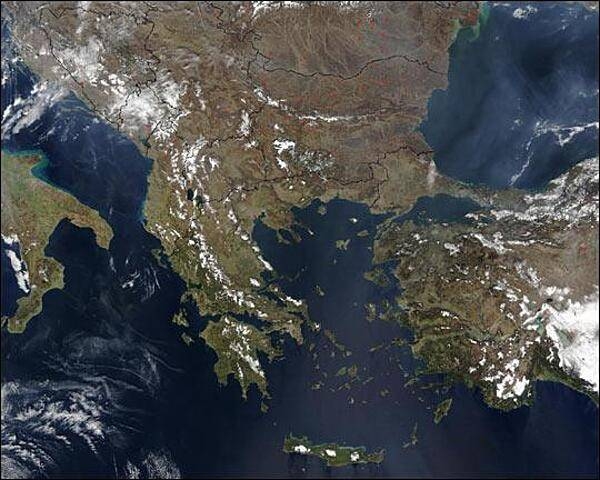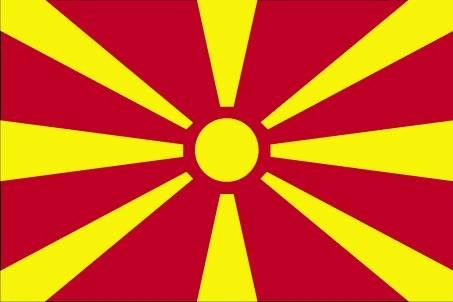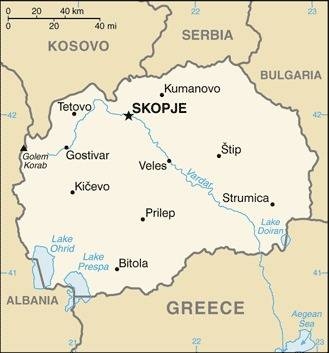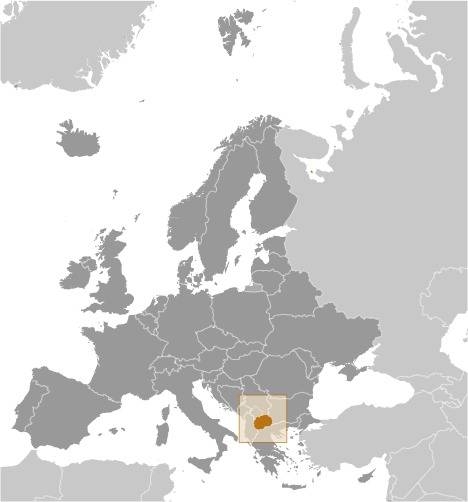North Macedonia
Introduction
Background
North Macedonia gained its independence peacefully from Yugoslavia in 1991 under the name of "Macedonia." Greek objection to the new country’s name, insisting it implied territorial pretensions to the northern Greek province of Macedonia, and democratic backsliding for several years stalled the country’s movement toward Euro-Atlantic integration. Immediately after Macedonia declared independence, Greece sought to block Macedonian efforts to gain UN membership if the name "Macedonia" was used. The country was eventually admitted to the UN in 1993 as "The former Yugoslav Republic of Macedonia," and at the same time it agreed to UN-sponsored negotiations on the name dispute. In 1995, Greece lifted a 20-month trade embargo and the two countries agreed to normalize relations, but the issue of the name remained unresolved and negotiations for a solution continued. Over time, the US and over 130 other nations recognized Macedonia by its constitutional name, Republic of Macedonia. Ethnic Albanian grievances over perceived political and economic inequities escalated into a conflict in 2001 that eventually led to the internationally brokered Ohrid Framework Agreement, which ended the fighting and established guidelines for constitutional amendments and the creation of new laws that enhanced the rights of minorities. In January 2018, the government adopted a new law on languages, which elevated the Albanian language to an official language at the national level, with the Macedonian language remaining the sole official language in international relations. Relations between ethnic Macedonians and ethnic Albanians remain complicated, however.
North Macedonia's pro-Western government has used its time in office since 2017 to sign a historic deal with Greece in June 2018 to end the name dispute and revive Skopje's NATO and EU membership prospects. This followed a nearly three-year political crisis that engulfed the country but ended in June 2017 following a six-month-long government formation period after a closely contested election in December 2016. The crisis began after the 2014 legislative and presidential election, and escalated in 2015 when the opposition party began releasing wiretapped material that revealed alleged widespread government corruption and abuse. Although an EU candidate since 2005, North Macedonia has yet to open EU accession negotiations. The country still faces challenges, including fully implementing reforms to overcome years of democratic backsliding and stimulating economic growth and development. In June 2018, Macedonia and Greece signed the Prespa Accord whereby the Republic of Macedonia agreed to change its name to the Republic of North Macedonia. Following ratification by both countries, the agreement went in to force on 12 February 2019. North Macedonia signed an accession protocol to become a NATO member state in February 2019.
Visit the Definitions and Notes page to view a description of each topic.
Geography
Location
Southeastern Europe, north of Greece
Geographic coordinates
41 50 N, 22 00 E
Map references
Europe
Area - comparative
slightly larger than Vermont; almost four times the size of Delaware
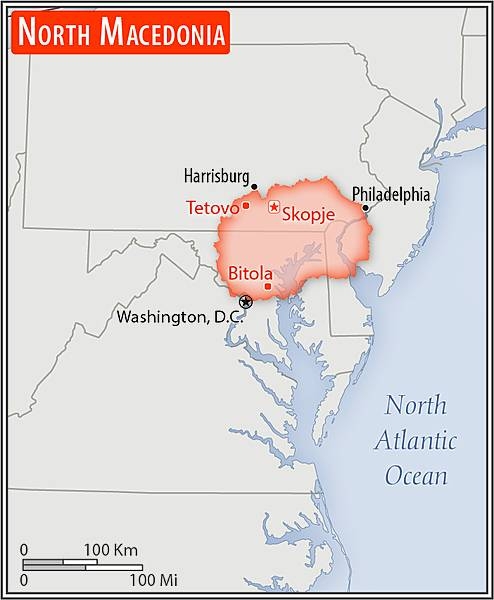
Land boundaries
total: 838 km
border countries (5): Albania 181 km; Bulgaria 162 km; Greece 234 km; Kosovo 160 km; Serbia 101 km
Coastline
0 km (landlocked)
Maritime claims
none (landlocked)
Climate
warm, dry summers and autumns; relatively cold winters with heavy snowfall
Terrain
mountainous with deep basins and valleys; three large lakes, each divided by a frontier line; country bisected by the Vardar River
Elevation
highest point: Golem Korab (Maja e Korabit) 2,764 m
lowest point: Vardar River 50 m
mean elevation: 741 m
Natural resources
low-grade iron ore, copper, lead, zinc, chromite, manganese, nickel, tungsten, gold, silver, asbestos, gypsum, timber, arable land
Land use
agricultural land: 44.3% (2018 est.)
arable land: 16.4% (2018 est.)
permanent crops: 1.4% (2018 est.)
permanent pasture: 26.5% (2018 est.)
forest: 39.8% (2018 est.)
other: 15.9% (2018 est.)
Irrigated land
844 sq km (2016)
Major watersheds (area sq km)
Atlantic Ocean drainage: (Black Sea) Danube (795,656 sq km)
Population distribution
a fairly even distribution throughout most of the country, with urban areas attracting larger and denser populations
Natural hazards
high seismic risks
Geography - note
landlocked; major transportation corridor from Western and Central Europe to Aegean Sea and Southern Europe to Western Europe
People and Society
Nationality
noun: Macedonian(s)
adjective: Macedonian
Ethnic groups
Macedonian 58.4%, Albanian 24.3%, Turkish 3.9%, Romani 2.5%, Serb 1.3%, other 2.3%, persons for whom data were taken from administrative sources and no ethnic affiliation data was available 7.2% (2021 est.)
note: data represent total resident population; Romani populations are usually underestimated in official statistics and may represent 6.5–13% of North Macedonia’s population
Languages
Macedonian (official) 61.4%, Albanian (official) 24.3%, Turkish 3.4%, Romani 1.7%, other (includes Aromanian (Vlach) and Bosnian) 2%, persons for whom data were taken from administrative sources and no language data was available 7.2% (2021 est.); note - data represent mother tongue; minority languages are co-official with Macedonian in municipalities where they are spoken by at least 20% of the population; Albanian is co-official in Tetovo, Brvenica, Vrapciste, and other municipalities; Turkish is co-official in Centar Zupa and Plasnica; Romani is co-official in Suto Orizari; Aromanian is co-official in Krusevo; Serbian is co-official in Cucer Sandevo
major-language sample(s):
Книга на Светски Факти, неопходен извор на основни информации. (Macedonian)
The World Factbook, the indispensable source for basic information.
Religions
Macedonian Orthodox 46.1%, Muslim 32.2%, other Christian 13.8%, other and non-believers 0.5%, unspecified 0.2%, persons for whom data were taken from administrative sources and no religious affiliation data was available 7.2% (2021 est.)
Age structure
0-14 years: 16.16% (male 177,553/female 165,992)
15-24 years: 12.65% (male 139,250/female 129,770)
25-54 years: 44.47% (male 480,191/female 465,145)
55-64 years: 12.55% (male 131,380/female 135,407)
65 years and over: 14.17% (male 131,674/female 169,609) (2020 est.)
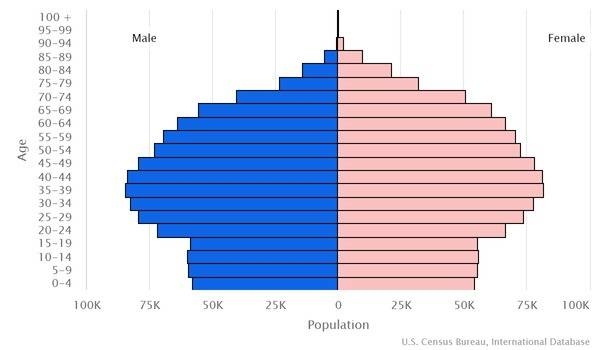
Dependency ratios
total dependency ratio: 44.6
youth dependency ratio: 23.2
elderly dependency ratio: 21.4
potential support ratio: 4.7 (2021 est.)
Median age
total: 39 years
male: 38 years
female: 40 years (2020 est.)
Population distribution
a fairly even distribution throughout most of the country, with urban areas attracting larger and denser populations
Urbanization
urban population: 59.5% of total population (2023)
rate of urbanization: 0.61% annual rate of change (2020-25 est.)
Major urban areas - population
611,000 SKOPJE (capital) (2023)
Sex ratio
at birth: 1.07 male(s)/female
0-14 years: 1.07 male(s)/female
15-24 years: 1.07 male(s)/female
25-54 years: 1.04 male(s)/female
55-64 years: 0.97 male(s)/female
65 years and over: 0.55 male(s)/female
total population: 0.99 male(s)/female (2022 est.)
Mother's mean age at first birth
26.9 years (2020 est.)
Maternal mortality ratio
7 deaths/100,000 live births (2017 est.)
country comparison to the world: 155Infant mortality rate
total: 7.32 deaths/1,000 live births
male: 8.27 deaths/1,000 live births
female: 6.31 deaths/1,000 live births (2022 est.)
Life expectancy at birth
total population: 76.84 years
male: 74.73 years
female: 79.08 years (2022 est.)
Contraceptive prevalence rate
59.9% (2018/19)
Drinking water source
improved: urban: 99.7% of population
rural: 99% of population
total: 99.4% of population
unimproved: urban: 0.3% of population
rural: 1% of population
total: 0.6% of population (2020 est.)
Current health expenditure
7.3% of GDP (2019)
Physicians density
2.87 physicians/1,000 population (2015)
Hospital bed density
4.3 beds/1,000 population (2017)
Sanitation facility access
improved: urban: 100% of population
rural: 98% of population
total: 99.2% of population
unimproved: urban: 0% of population
rural: 2% of population
total: 0.8% of population (2020 est.)
Alcohol consumption per capita
total: 3.9 liters of pure alcohol (2019 est.)
beer: 1.93 liters of pure alcohol (2019 est.)
wine: 1.03 liters of pure alcohol (2019 est.)
spirits: 0.9 liters of pure alcohol (2019 est.)
other alcohols: 0.03 liters of pure alcohol (2019 est.)
Child marriage
women married by age 15: 0.3%
women married by age 18: 7.5% (2019 est.)
Literacy
definition: age 15 and over can read and write
total population: 98.4%
male: 99.1%
female: 97.6% (2020)
School life expectancy (primary to tertiary education)
total: 13 years
male: 13 years
female: 14 years (2020)
Youth unemployment rate (ages 15-24)
total: 36.4%
male: 33.5%
female: 41.5% (2021 est.)
Environment
Environment - current issues
air pollution from metallurgical plants; Skopje has severe air pollution problems every winter as a result of industrial emissions, smoke from wood-buring stoves, and exhaust fumes from old cars
Environment - international agreements
party to: Air Pollution, Air Pollution-Heavy Metals, Air Pollution-Multi-effect Protocol, Air Pollution-Nitrogen Oxides, Air Pollution-Persistent Organic Pollutants, Air Pollution-Sulphur 85, Air Pollution-Sulphur 94, Air Pollution-Volatile Organic Compounds, Biodiversity, Climate Change, Climate Change-Kyoto Protocol, Climate Change-Paris Agreement, Comprehensive Nuclear Test Ban, Desertification, Endangered Species, Hazardous Wastes, Law of the Sea, Ozone Layer Protection, Wetlands
signed, but not ratified: none of the selected agreements
Air pollutants
particulate matter emissions: 28.34 micrograms per cubic meter (2016 est.)
carbon dioxide emissions: 7.05 megatons (2016 est.)
methane emissions: 2.28 megatons (2020 est.)
Climate
warm, dry summers and autumns; relatively cold winters with heavy snowfall
Land use
agricultural land: 44.3% (2018 est.)
arable land: 16.4% (2018 est.)
permanent crops: 1.4% (2018 est.)
permanent pasture: 26.5% (2018 est.)
forest: 39.8% (2018 est.)
other: 15.9% (2018 est.)
Urbanization
urban population: 59.5% of total population (2023)
rate of urbanization: 0.61% annual rate of change (2020-25 est.)
Revenue from forest resources
forest revenues: 0.15% of GDP (2018 est.)
country comparison to the world: 102Waste and recycling
municipal solid waste generated annually: 796,585 tons (2016 est.)
municipal solid waste recycled annually: 1,434 tons (2013 est.)
percent of municipal solid waste recycled: 0.2% (2013 est.)
Major watersheds (area sq km)
Atlantic Ocean drainage: (Black Sea) Danube (795,656 sq km)
Total water withdrawal
municipal: 277.5 million cubic meters (2017 est.)
industrial: 225,809,581.6 cubic meters (2017 est.)
agricultural: 329,217,707.7 cubic meters (2017 est.)
Total renewable water resources
6.4 billion cubic meters (2017 est.)
Government
Country name
conventional long form: Republic of North Macedonia
conventional short form: North Macedonia
local long form: Republika Severna Makedonija
local short form: Severna Makedonija
former: Democratic Federal Macedonia, People's Republic of Macedonia, Socialist Republic of Macedonia, Republic of Macedonia
etymology: the country name derives from the ancient kingdom of Macedon (7th to 2nd centuries B.C.)
Government type
parliamentary republic
Capital
name: Skopje
geographic coordinates: 42 00 N, 21 26 E
time difference: UTC+1 (6 hours ahead of Washington, DC, during Standard Time)
daylight saving time: +1hr, begins last Sunday in March; ends last Sunday in October
etymology: Skopje derives from its ancient name Scupi, the Latin designation of a classical era Greco-Roman frontier fortress town; the name may go back even further to a pre-Greek, Illyrian name
Administrative divisions
70 municipalities (opstini, singular - opstina) and 1 city* (grad); Aracinovo, Berovo, Bitola, Bogdanci, Bogovinje, Bosilovo, Brvenica, Caska, Centar Zupa, Cesinovo-Oblesevo, Cucer Sandevo, Debar, Debarca, Delcevo, Demir Hisar, Demir Kapija, Dojran, Dolneni, Gevgelija, Gostivar, Gradsko, Ilinden, Jegunovce, Karbinci, Kavadarci, Kicevo, Kocani, Konce, Kratovo, Kriva Palanka, Krivogastani, Krusevo, Kumanovo, Lipkovo, Lozovo, Makedonska Kamenica, Makedonski Brod, Mavrovo i Rostuse, Mogila, Negotino, Novaci, Novo Selo, Ohrid, Pehcevo, Petrovec, Plasnica, Prilep, Probistip, Radovis, Rankovce, Resen, Rosoman, Skopje*, Sopiste, Staro Nagoricane, Stip, Struga, Strumica, Studenicani, Sveti Nikole, Tearce, Tetovo, Valandovo, Vasilevo, Veles, Vevcani, Vinica, Vrapciste, Zelenikovo, Zelino, Zrnovci
Independence
8 September 1991 (referendum by registered voters endorsed independence from Yugoslavia)
National holiday
Independence Day, 8 September (1991), also known as National Day
Constitution
history: several previous; latest adopted 17 November 1991, effective 20 November 1991
amendments: proposed by the president of the republic, by the government, by at least 30 members of the Assembly, or by petition of at least 150,000 citizens; final approval requires a two-thirds majority vote by the Assembly; amended several times, last in 2019
Legal system
civil law system; judicial review of legislative acts
International law organization participation
has not submitted an ICJ jurisdiction declaration; accepts ICCt jurisdiction
Citizenship
citizenship by birth: no
citizenship by descent only: at least one parent must be a citizen of North Macedonia
dual citizenship recognized: no
residency requirement for naturalization: 8 years
Suffrage
18 years of age; universal
Executive branch
chief of state: President Stevo PENDAROVSKI (since 12 May 2019)
head of government: Prime Minister Dimitar KOVACEVSKI (since 16 January 2022)
cabinet: Council of Ministers elected by the Assembly by simple majority vote
elections/appointments: president directly elected using a modified 2-round system; a candidate can only be elected in the first round with an absolute majority from all registered voters; in the second round, voter turnout must be at least 40% for the result to be deemed valid; president elected for a 5-year term (eligible for a second term); election last held on 21 April and 5 May 2019 (next to be held in 2024); following legislative elections, the leader of the majority party or majority coalition is usually elected prime minister by the Assembly; Dimitar KOVACEVSKI elected prime minister by the Assembly on 16 January 2022; Assembly vote - NA
election results: 2019: Stevo PENDAROVSKI elected president in second round; percent of vote in first round - Stevo PENDAROVSKI (SDSM) 44.8%, Gordana SILJANOVSKA-DAVKOVA (VMRO-DPMNE) 44.2%, Blenim REKA (independent) 11.1%; percent of vote in second round - Stevo PENDAROVSKI 53.6%, Gordana SILJANOVSKA-DAVKOVA 46.4%
2014: Gjorge IVANOV reelected president in second round; percent of vote in first round - Gjorge IVANOV (VMRO-DPMNE) 53.1%, Stevo PENDAROVSKI (SDSM) 38.6%, Ilijaz HALIMI (DPA) 4.6%, Zoran POPOVSKI (GROM) 3.7%; percent of vote in second round - Gjorge IVANOV 57.3%, Stevo PENDAROVSKI (SDSM) 42.7%
Legislative branch
description: unicameral Assembly - Sobraine in Macedonian, Kuvend in Albanian (between 120 and 140 seats, currently 120; members directly elected in multi-seat constituencies by closed-list proportional representation vote; possibility of 3 directly elected in diaspora constituencies by simple majority vote provided there is sufficient voter turnout; members serve 4-year terms)
elections: last held on 15 July 2020 (next to be held in 2024)
election results: percent of vote by party/coalition - We Can 35.9%, Renewal 34.6%, BDI 11.5%, AfA-Alternative 9%, The Left 4.1%, PDSh 1.5%, other 3.4%; seats by party/coalition - We Can 46, Renewal 44, BDI 15, AfA-Alternative 12, The Left 2, PDSh 1; composition - men 70, women 50, percent of women 41.7%
Judicial branch
highest court(s): Supreme Court (consists of 22 judges); Constitutional Court (consists of 9 judges)
judge selection and term of office: Supreme Court judges nominated by the Judicial Council, a 7-member body of legal professionals, and appointed by the Assembly; judge tenure NA; Constitutional Court judges appointed by the Assembly for nonrenewable, 9-year terms
subordinate courts: Courts of Appeal; Basic Courts
Political parties and leaders
Alliance for Albanians or AfA [Ziadin SELA]
Alternative (Alternativa) [Afrim GASHI]
Besa Movement [Bilal KASAMI]
Democratic Party of Albanians or PDSh [Menduh THACI]
Democratic Union for Integration or BDI [Ali AHMETI]
Internal Macedonian Revolutionary Organization - Democratic Party for Macedonian National Unity or VMRO-DPMNE [Hristijan MICKOSKI]
Internal Macedonian Revolutionary Organization - People's Party or VMRO-NP [Ljubco GEORGIEVSKI]
Liberal Democratic Party or LDP [Goran MILEVSKI]
Renewal (VMRO-DPMNE coalition) [Maja MORACHANIN]
Social Democratic Union of Macedonia or SDSM [Dimitar KOVACHEVSKI]
The Left (Levica) [Dimitar APASIEV]
Turkish Democratic Party of DPT [Beycan ILYAS]
We Can (coalition includes SDSM/Besa/VMRO-NP, DPT, LDP)
International organization participation
BIS, CD, CE, CEI, EAPC, EBRD, EU (candidate country), FAO, IAEA, IBRD, ICAO, ICC (NGOs), ICCt, ICRM, IDA, IFAD, IFC, IFRCS, ILO, IMF, IMO, Interpol, IOC, IOM, IPU, ISO, ITU, ITUC (NGOs), MIGA, NATO, OAS (observer), OIF, OPCW, OSCE, PCA, PFP, SELEC, UN, UNCTAD, UNESCO, UNHCR, UNIDO, UNIFIL, UNWTO, UPU, WCO, WHO, WIPO, WMO, WTO
note: North Macedonia is an EU candidate country whose satisfactory completion of accession criteria is required before being granted full EU membership
Diplomatic representation in the US
chief of mission: Ambassador Zoran POPOV (since 16 September 2022)
chancery: 2129 Wyoming Avenue NW, Washington, DC 20008
telephone: [1] (202) 667-0501
FAX: [1] (202) 667-2131
email address and website:
washington@mfa.gov.mk
consulate(s) general: Chicago, Detroit, New York
Diplomatic representation from the US
chief of mission: Ambassador Kate Marie BYRNES (since 12 July 2019)
embassy: Str. Samoilova, Nr. 21, 1000 Skopje
mailing address: 7120 Skopje Place, Washington, DC 20521-7120
telephone: [389] (2) 310-2000
FAX: [389] (2) 310-2499
email address and website:
SkopjeACS@state.gov
https://mk.usembassy.gov/
Flag description
a yellow sun (the Sun of Liberty) with eight broadening rays extending to the edges of the red field; the red and yellow colors have long been associated with Macedonia
National symbol(s)
eight-rayed sun; national colors: red, yellow
National anthem
name: "Denes nad Makedonija" (Today Over Macedonia)
lyrics/music: Vlado MALESKI/Todor SKALOVSKI
note: written in 1943 and adopted in 1991, the song previously served as the anthem of the Socialist Republic of Macedonia while part of Yugoslavia
National heritage
total World Heritage Sites: 2 (both natural)
selected World Heritage Site locales: Natural and Cultural Heritage of the Ohrid Region; Ancient and Primeval Beech Forests of the Carpathians
Economy
Economic overview
Since its independence in 1991, Macedonia has made progress in liberalizing its economy and improving its business environment. Its low tax rates and free economic zones have helped to attract foreign investment, which is still low relative to the rest of Europe. Corruption and weak rule of law remain significant problems. Some businesses complain of opaque regulations and unequal enforcement of the law.
Macedonia’s economy is closely linked to Europe as a customer for exports and source of investment, and has suffered as a result of prolonged weakness in the euro zone. Unemployment has remained consistently high at about 23% but may be overstated based on the existence of an extensive gray market, estimated to be between 20% and 45% of GDP, which is not captured by official statistics.
Macedonia is working to build a country-wide natural gas pipeline and distribution network. Currently, Macedonia receives its small natural gas supplies from Russia via Bulgaria. In 2016, Macedonia signed a memorandum of understanding with Greece to build an interconnector that could connect to the Trans Adriatic Pipeline that will traverse the region once complete, or to an LNG import terminal in Greece.
Macedonia maintained macroeconomic stability through the global financial crisis by conducting prudent monetary policy, which keeps the domestic currency pegged to the euro, and inflation at a low level. However, in the last two years, the internal political crisis has hampered economic performance, with GDP growth slowing in 2016 and 2017, and both domestic private and public investments declining. Fiscal policies were lax, with unproductive public expenditures, including subsidies and pension increases, and rising guarantees for the debt of state owned enterprises, and fiscal targets were consistently missed. In 2017, public debt stabilized at about 47% of GDP, still relatively low compared to its Western Balkan neighbors and the rest of Europe.
Real GDP (purchasing power parity)
$33.02 billion (2020 est.)
$34.59 billion (2019 est.)
$33.52 billion (2018 est.)
note: data are in 2017 dollars; Macedonia has a large informal sector that may not be reflected in these data
Real GDP growth rate
0% (2017 est.)
2.9% (2016 est.)
3.9% (2015 est.)
Real GDP per capita
$15,800 (2020 est.)
$16,600 (2019 est.)
$16,100 (2018 est.)
note: data are in 2017 dollars
GDP (official exchange rate)
$12.696 billion (2019 est.)
Inflation rate (consumer prices)
0.7% (2019 est.)
1.4% (2018 est.)
1.3% (2017 est.)
Credit ratings
Fitch rating: BB+ (2019)
Standard & Poors rating: BB- (2013)
note: The year refers to the year in which the current credit rating was first obtained.
GDP - composition, by sector of origin
agriculture: 10.9% (2017 est.)
industry: 26.6% (2017 est.)
services: 62.5% (2017 est.)
GDP - composition, by end use
household consumption: 65.6% (2017 est.)
government consumption: 15.6% (2017 est.)
investment in fixed capital: 13.6% (2017 est.)
investment in inventories: 20.2% (2017 est.)
exports of goods and services: 54% (2017 est.)
imports of goods and services: -69% (2017 est.)
Agricultural products
milk, grapes, wheat, potatoes, green chillies/peppers, cabbages, tomatoes, maize, barley, watermelons
Industries
food processing, beverages, textiles, chemicals, iron, steel, cement, energy, pharmaceuticals, automotive parts
Labor force - by occupation
agriculture: 16.2%
industry: 29.2%
services: 54.5% (2017 est.)
Youth unemployment rate (ages 15-24)
total: 36.4%
male: 33.5%
female: 41.5% (2021 est.)
Population below poverty line
21.6% (2018 est.)
Gini Index coefficient - distribution of family income
34.2 (2017 est.)
35.2 (2014)
Household income or consumption by percentage share
lowest 10%: 1.7%
highest 10%: 25% (2015 est.)
Budget
revenues: 3.295 billion (2017 est.)
expenditures: 3.605 billion (2017 est.)
Public debt
39.3% of GDP (2017 est.)
39.5% of GDP (2016 est.)
note: official data from Ministry of Finance; data cover central government debt; this data excludes debt instruments issued (or owned) by government entities other than the treasury; includes treasury debt held by foreign entitites; excludes debt issued by sub-national entities; there are no debt instruments sold for social funds
Fiscal year
calendar year
Current account balance
-$151 million (2017 est.)
-$293 million (2016 est.)
Exports
$7.18 billion (2020 est.) note: data are in current year dollars
$7.78 billion (2019 est.) note: data are in current year dollars
$7.61 billion (2018 est.) note: data are in current year dollars
Exports - partners
Germany 45%, Serbia 8%, Bulgaria 5% (2019)
Exports - commodities
support catalysts, centrifuges, insulated wiring, vehicle parts, buses, seats (2019)
Imports
$8.76 billion (2020 est.) note: data are in current year dollars
$9.6 billion (2019 est.) note: data are in current year dollars
$9.23 billion (2018 est.) note: data are in current year dollars
Imports - partners
United Kingdom 14%, Germany 14%, Greece 8%, Serbia 8% (2019)
Imports - commodities
platinum, refined petroleum, laboratory ceramics, cars, insulated wiring (2019)
Reserves of foreign exchange and gold
$2.802 billion (31 December 2017 est.)
$2.755 billion (31 December 2016 est.)
Debt - external
$9.065 billion (2019 est.)
$9.398 billion (2018 est.)
Exchange rates
Macedonian denars (MKD) per US dollar -
55.8 (2017 est.)
55.733 (2016 est.)
55.733 (2015 est.)
55.537 (2014 est.)
46.437 (2013 est.)
Energy
Electricity access
electrification - total population: 100% (2020)
Electricity
installed generating capacity: 1.928 million kW (2020 est.)
consumption: 6,350,982,000 kWh (2019 est.)
exports: 639 million kWh (2020 est.)
imports: 2.965 billion kWh (2020 est.)
transmission/distribution losses: 979 million kWh (2019 est.)
Electricity generation sources
fossil fuels: 71.4% of total installed capacity (2020 est.)
nuclear: 0% of total installed capacity (2020 est.)
solar: 0.5% of total installed capacity (2020 est.)
wind: 2.3% of total installed capacity (2020 est.)
hydroelectricity: 24.7% of total installed capacity (2020 est.)
tide and wave: 0% of total installed capacity (2020 est.)
geothermal: 0% of total installed capacity (2020 est.)
biomass and waste: 1.1% of total installed capacity (2020 est.)
Coal
production: 5.026 million metric tons (2020 est.)
consumption: 5.211 million metric tons (2020 est.)
exports: 1,000 metric tons (2020 est.)
imports: 174,000 metric tons (2020 est.)
proven reserves: 332 million metric tons (2019 est.)
Petroleum
total petroleum production: 0 bbl/day (2021 est.)
refined petroleum consumption: 22,700 bbl/day (2019 est.)
crude oil and lease condensate exports: 0 bbl/day (2018 est.)
crude oil and lease condensate imports: 0 bbl/day (2018 est.)
crude oil estimated reserves: 0 barrels (2021 est.)
Natural gas
production: 0 cubic meters (2021 est.)
consumption: 218.917 million cubic meters (2019 est.)
exports: 0 cubic meters (2021 est.)
imports: 218.917 million cubic meters (2019 est.)
proven reserves: 0 cubic meters (2021 est.)
Carbon dioxide emissions
7.383 million metric tonnes of CO2 (2019 est.)
from coal and metallurgical coke: 3.866 million metric tonnes of CO2 (2019 est.)
from petroleum and other liquids: 3.094 million metric tonnes of CO2 (2019 est.)
from consumed natural gas: 423,000 metric tonnes of CO2 (2019 est.)
Energy consumption per capita
53.572 million Btu/person (2019 est.)
country comparison to the world: 96Communications
Telephones - fixed lines
total subscriptions: 415,390 (2020 est.)
subscriptions per 100 inhabitants: 20 (2020 est.)
Telephones - mobile cellular
total subscriptions: 1,862,138 (2020 est.)
subscriptions per 100 inhabitants: 89 (2020 est.)
Telecommunication systems
general assessment: as part of the EU pre-accession process, North Macedonia has built closer economic ties with the Union which accounts for 77.5% of Macedonia’s exports and just over half of its imports; closer regulatory and administrative ties with European Commission (EC) institutions have done much to develop the telecom sector and prepare the market for the competitive environment encouraged in the EU; as part of EU integration legislation North Macedonia has implemented the principles of the EU’s regulatory framework for communications, established an independent regulator and set out several provisions to provide for a competitive telecom market, including wholesale access to the incumbent’s fixed-line network; broadband services are widely available, with effective competition between DSL and cable platforms complemented by wireless broadband and a developing fiber sector; the number of DSL subscribers has continued to fall in recent years as customers are migrated to fiber networks; the MNOs are increasingly focused on expanding their 5G networks, seeking stronger coverage across North Macedonia’s high value urban areas; mobile data services are also becoming increasingly important following investments in LTE network rollouts and in upgrades to LTE-A technology (2022)
domestic: fixed-line roughly 20 per 100 and mobile-cellular 89 per 100 subscriptions (2020)
international: country code - 389
note: the COVID-19 pandemic continues to have a significant impact on production and supply chains globally; since 2020, some aspects of the telecom sector have experienced a downturn, particularly in mobile device production; progress toward 5G implementation has resumed, as well as upgrades to infrastructure; consumer spending on telecom services has increased due to the surge in demand for capacity and bandwidth; the crucial nature of telecom services as a tool for work and school from home is still evident, and the spike in this area has seen growth opportunities for development of new tools and increased services
Broadcast media
public service TV broadcaster Macedonian Radio and Television operates 3 national terrestrial TV channels and 2 satellite TV channels; additionally, there are 10 regional TV stations that broadcast nationally using terrestrial transmitters, 54 TV channels with concession for cable TV, 9 regional TV stations with concessions for cable TV; 4 satellite TV channels broadcasting on a national level, 21 local commercial TV channels, and a large number of cable operators that offer domestic and international programming; the public radio broadcaster operates over 3 stations; there are 4 privately owned radio stations that broadcast nationally; 17 regional radio stations, and 49 local commercial radio stations (2019)
Internet users
total: 1,678,750 (2020 est.)
percent of population: 81% (2020 est.)
Broadband - fixed subscriptions
total: 475,569 (2020 est.)
subscriptions per 100 inhabitants: 23 (2020 est.)
Transportation
Airports - with paved runways
total: 8
2,438 to 3,047 m: 2
under 914 m: 6 (2021)
Airports - with unpaved runways
total: 2
914 to 1,523 m: 1
under 914 m: 1 (2021)
Pipelines
262 km gas, 120 km oil (2017)
Railways
total: 925 km (2017)
standard gauge: 925 km (2017) 1.435-m gauge (313 km electrified)
Roadways
total: 14,182 km (2017) (includes 290 km of expressways)
paved: 9,633 km (2017)
unpaved: 4,549 km (2017)
Military and Security
Military and security forces
Army of the Republic of North Macedonia (ARSM; includes a General Staff and subordinate Operations Command, Logistic Support Command, Training and Doctrine Command, Center for Electronic Reconnaissance, Aviation Brigade, and Honor Guard Battalion) (2022)
note: the Operations Command includes air, ground, special operations, support, and reserve forces
Military expenditures
1.8% of GDP (2022 est.)
1.5% of GDP (2021)
1.3% of GDP (2020)
1.2% of GDP (2019) (approximately $310 million)
0.9% of GDP (2018) (approximately $280 million)
Military and security service personnel strengths
approximately 6,000 active duty personnel (2022)
Military equipment inventories and acquisitions
the military's inventory consists mostly of Soviet-era equipment; since 2010, it has received small amounts of equipment from Ireland and Turkey (2021)
Military service age and obligation
18 years of age for voluntary military service; conscription abolished in 2007 (2021)
note: as of 2022, women made up about 10% of the military's full-time personnel
Military - note
North Macedonia became the 30th member of NATO in 2020; as of 2022, Greece provided NATO's air policing mission for North Macedonia
Terrorism
Terrorist group(s)
Islamic State of Iraq and ash-Sham (ISIS)
note: details about the history, aims, leadership, organization, areas of operation, tactics, targets, weapons, size, and sources of support of the group(s) appear(s) in Appendix-T
Transnational Issues
Disputes - international
North Macedonia-Albania: none identified
North Macedonia-Greece: none identified
North Macedonia-Kosovo: North Macedonia and Kosovo completed demarcation of their boundary in October 2009
North Macedonia-Serbia: none identified
Refugees and internally displaced persons
refugees (country of origin): 6,430 (Ukraine) (as of 20 December 2022)
stateless persons: 553 (mid-year 2021)
note: 549,217 estimated refugee and migrant arrivals (January 2015-October 2022)
Illicit drugs
major transshipment point for Southwest Asian heroin and hashish; minor transit point for South American cocaine destined for Europe; although not a financial center and most criminal activity is thought to be domestic, money laundering is a problem due to a mostly cash-based economy and weak enforcement
